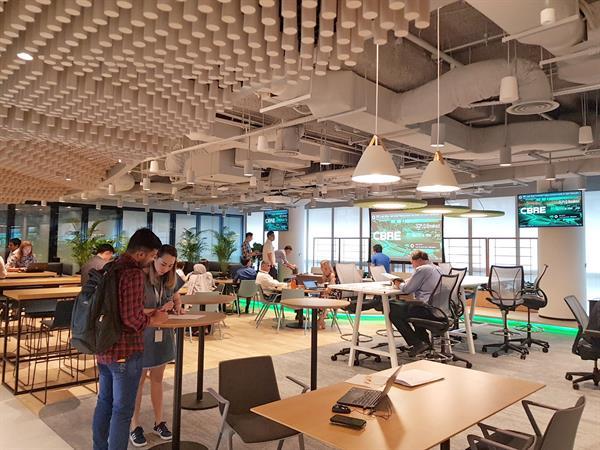A lot has changed since fax machines, and boxy cubicles were mainstays in offices around the world. Thanks to changes in work styles, technological advancements and space allocation as well as cultural shifts, the workplace has drastically transformed over the past decade. Increasingly, more Thai and Multinational companies in Bangkok are recognizing these changes when it comes to both the selection of office buildings and design of their workspace.
“Based on CBRE’s research, the primary goals for organizations remain the same: attracting and retaining top talent, enabling this talent to successfully achieve organizational goals, and doing all of this in a fiscally responsible manner,” says Ms. Roongrat Veeraparkkaroon, Head of Advisory & Transaction Services – Office at CBRE Thailand.
“What is changing is the role the workplace plays in enabling these goals. Top performing organizations recognize the important value of their workplace as a destination for their people – a place that brings them together as a community, fosters culture and connection to purpose, and gives them the resources to be their most effective,” Ms. Roongrat added.
Today, there is a new consumer mindset at play when it comes to employee perceptions. More and more companies view their employees as consumers, which trickles down into how they design workspaces to support that ideology.
Organizations are providing environments that are conducive to keeping employees happy, healthy and, of course, productive and efficient. For example, employees have grown accustomed to amenities they could only dream of in previous decades. Previously, only a canteen serving economical food, a convenience store, coffee shop and bank branches or ATM’s were seen as being essential amenities in an office building. Today, employees want a range of healthy eating options but at affordable prices, gyms and a range of other amenities.
Lavish amenities aren’t the only way workspaces have changed over the years. Layouts and design have also undergone major overhauls. Private corner offices with heavy wooden doors and traditional square cubicles have long gone. Today’s modern offices tout transparency, community and collaboration, and prioritize equal support of tasks over hierarchy, which typically translates to environments that provide a wide variety of open and enclosed settings. While these updated designs are more commonplace, it doesn’t necessarily mean they’re unanimously effective.
CBRE Singapore’s New Head Office – A Showcase and Testbed for New Prop Tech Offerings
According to CBRE Research, “Open communal tables where no one has privacy only work if employees can still get their work done. If you come to work and can’t be productive, it creates a huge amount of anxiety.”
Ultimately, a company’s bottom line depends on the output of its employees. Successful layouts and designs are never a one size fits all for every type of occupier.
When employees are in the space, technology has been a catalyst for improved communication and efficiency. Further, companies are now using smart building technologies to provide an added layer of creative environments that are more responsive to people’s needs, while also ensuring efficiency of space. For example, companies are using technologies that detect and respond to human movement. This includes everything from motion-activated room sensors to sonar that emits from light fixtures to hypersensitive air monitoring that can measure the occupancy of a conference room based on the amount of carbon dioxide production in the room.
Thai developers are going to have to adapt the design of their buildings to account for these changes. Floor plates will have to accommodate a range of different office layouts. Flexible workplace strategies where employees do not have a permanent, exclusive use desk mean that population densities are going to be higher, with more people in less space. Lifts, air conditioning and washrooms will need to be designed to deal with this increased density.
Wellness is becoming a more important factor and tenants are going to look at natural light and ability to adjust lighting levels and, given the level of pollution in Bangkok, questions will be raised about measures in the building to ensure air quality.
The additional common amenities need to be considered carefully. Tenants want them but the rents that these amenity tenants can pay are based on only being able to generate revenue during business hours, five days a week. In the best central business district (CBD) Grade A office buildings, rents paid by amenity tenants are lower than office rents. Operating costs are more expensive because of the need to air-condition and maintain large common areas and the provision of air conditioning to these tenants for long hours.
Increasingly, tenants are having to adapt by designing workspace that is both efficient, encourages productivity and attracts top talent.
The overall impact will be that the buildings that can best accommodate tenants’ needs will be able to achieve premium rents. Tenants may be able to pay more per square metre when they move if they fit more people into less space, but there is still going to be a ceiling on that premium because tenants are still going to be concerned with overall cost.
Landlords of new buildings will have to think carefully about design, specification and amenities and look carefully at tenants’ requirements.
Tenants are going to have to think far more about their workplace strategy and have that worked out before they start to look at where to rent space and how to design that space. This will result in a far longer decision-making process. For large companies, that will mean commencing the strategy and selection process at least 18 months before space is required.
CBRE is responding to these changes by investing more in staff and resources to deliver advice on workspace strategy to both landlords and tenants.

